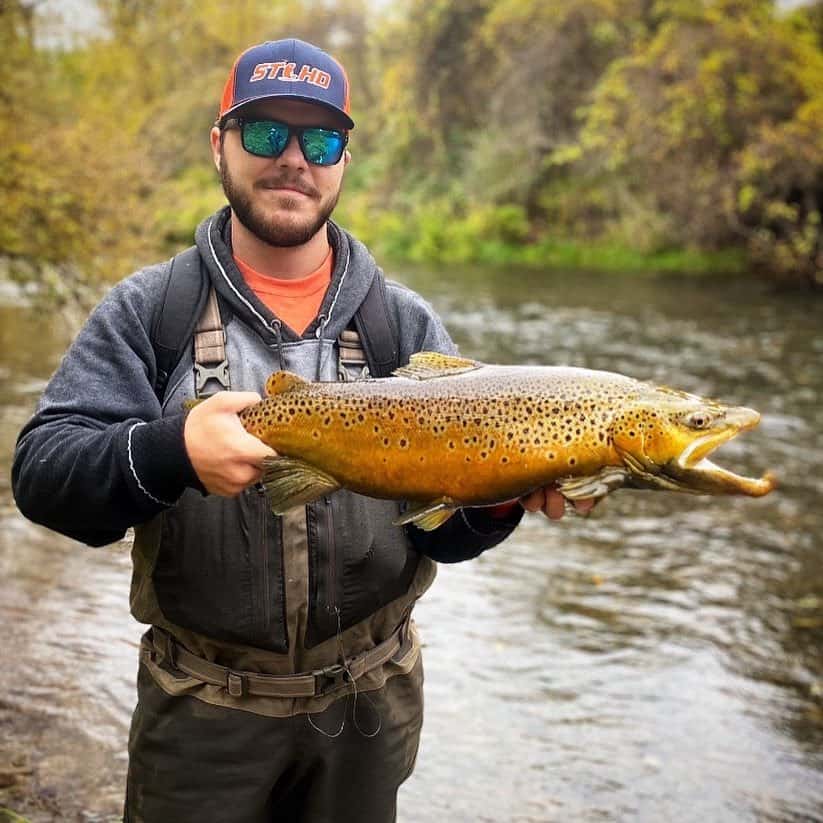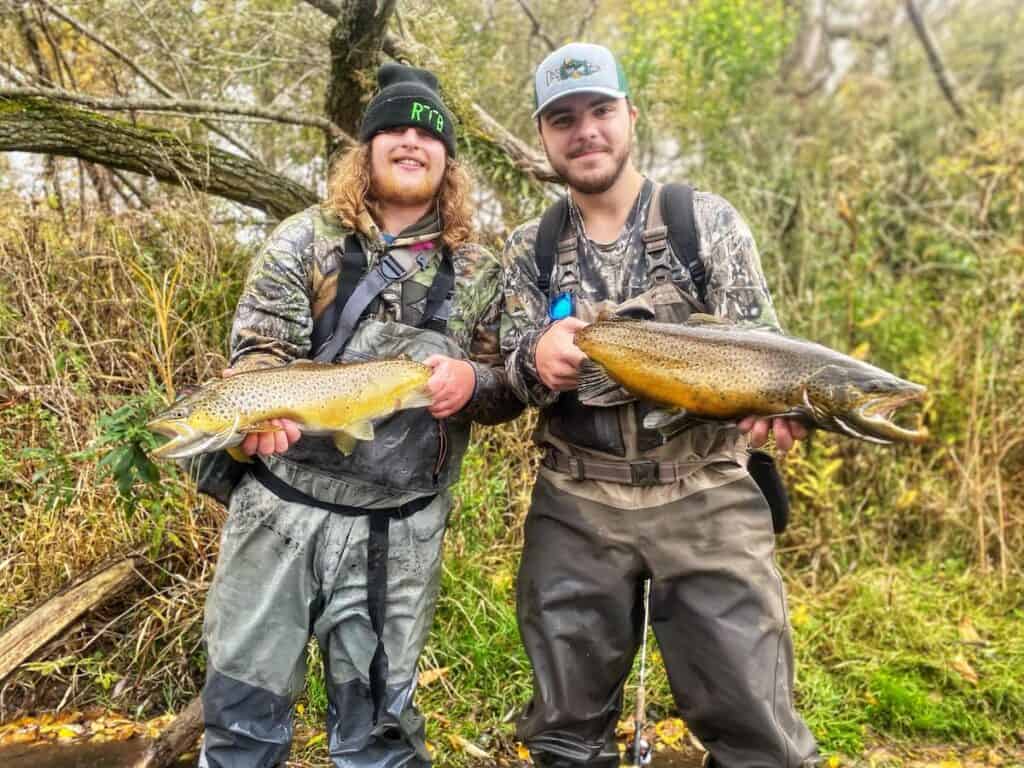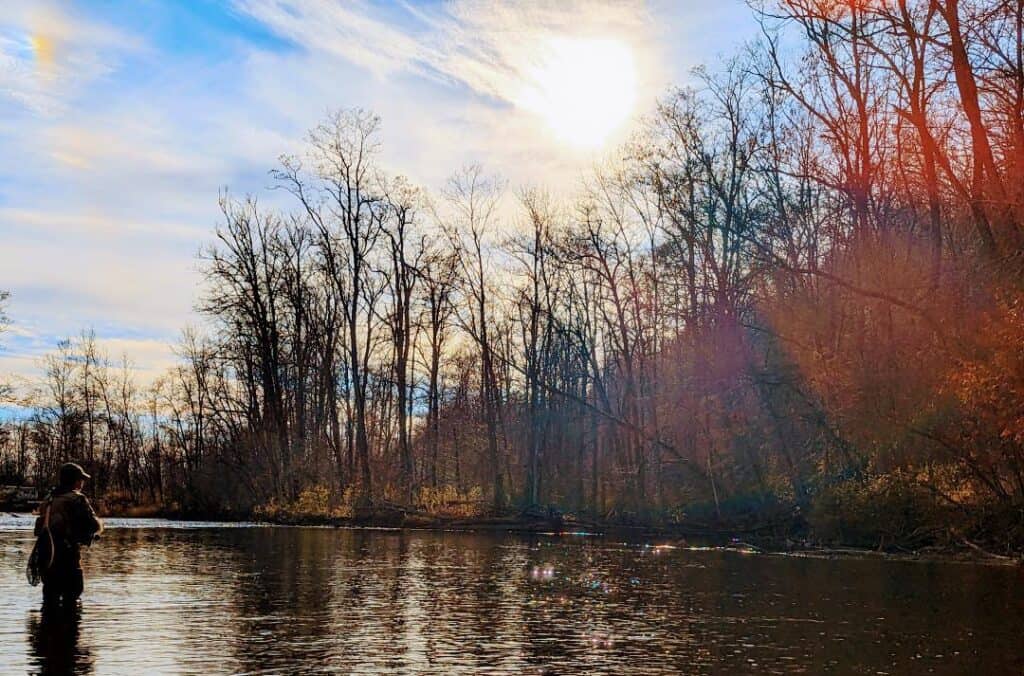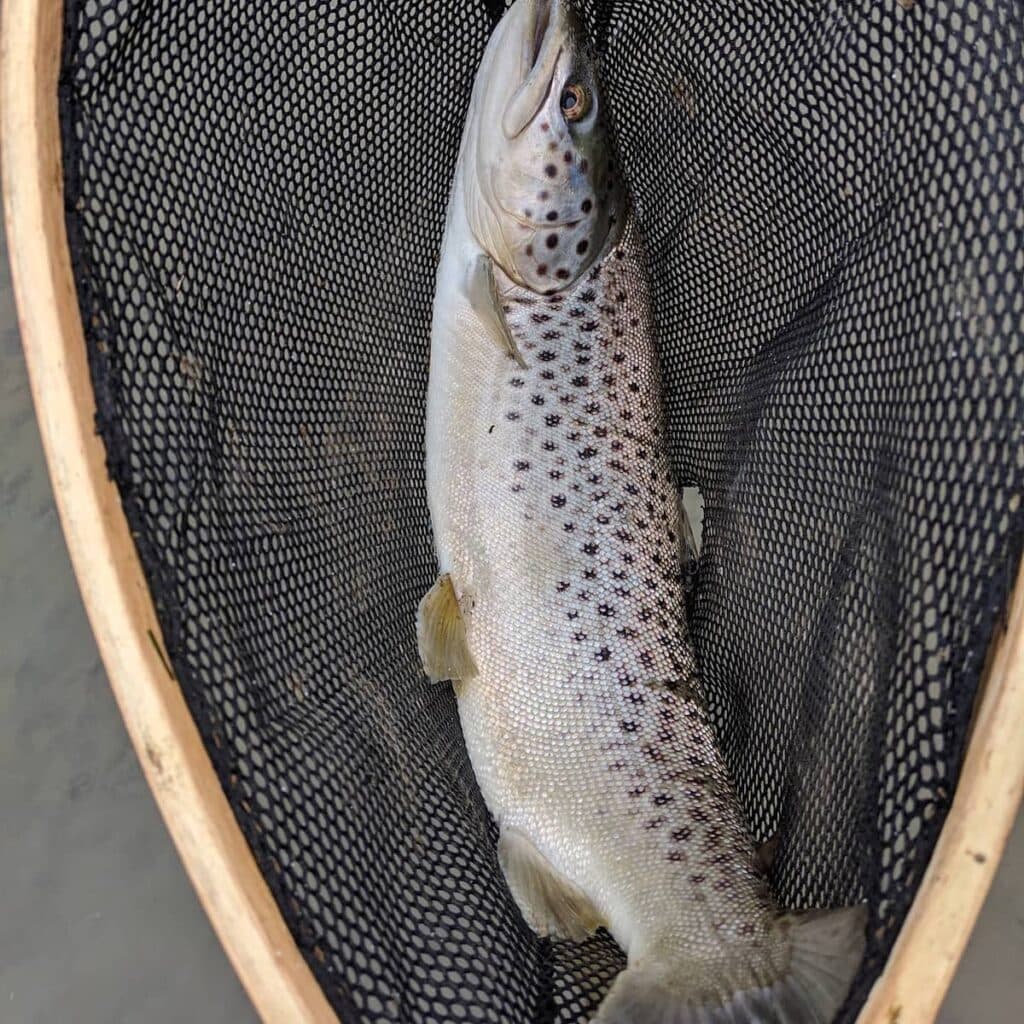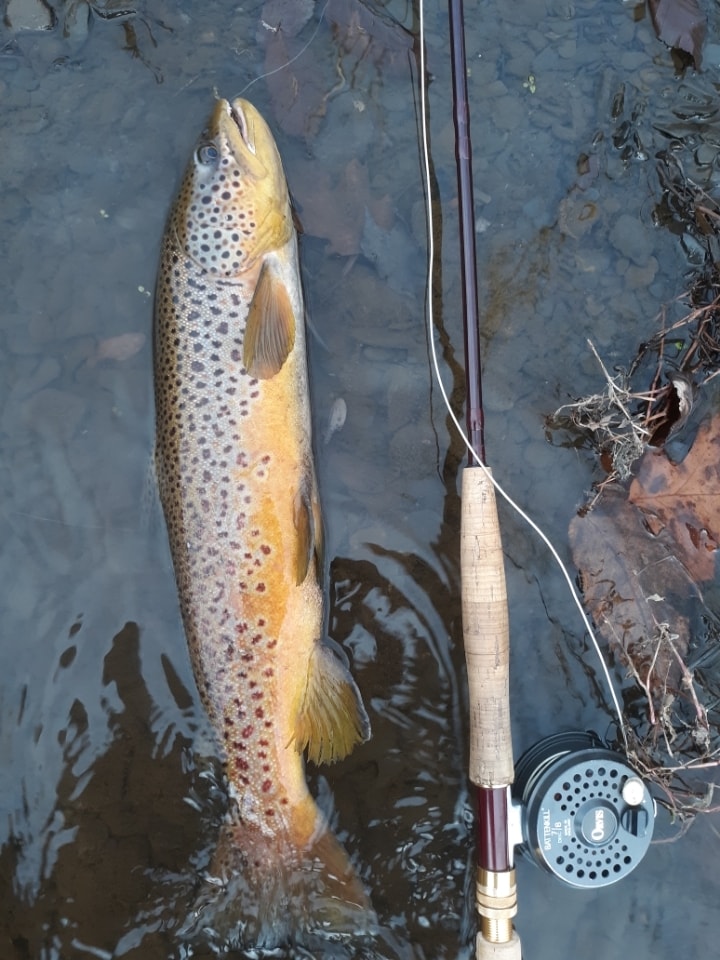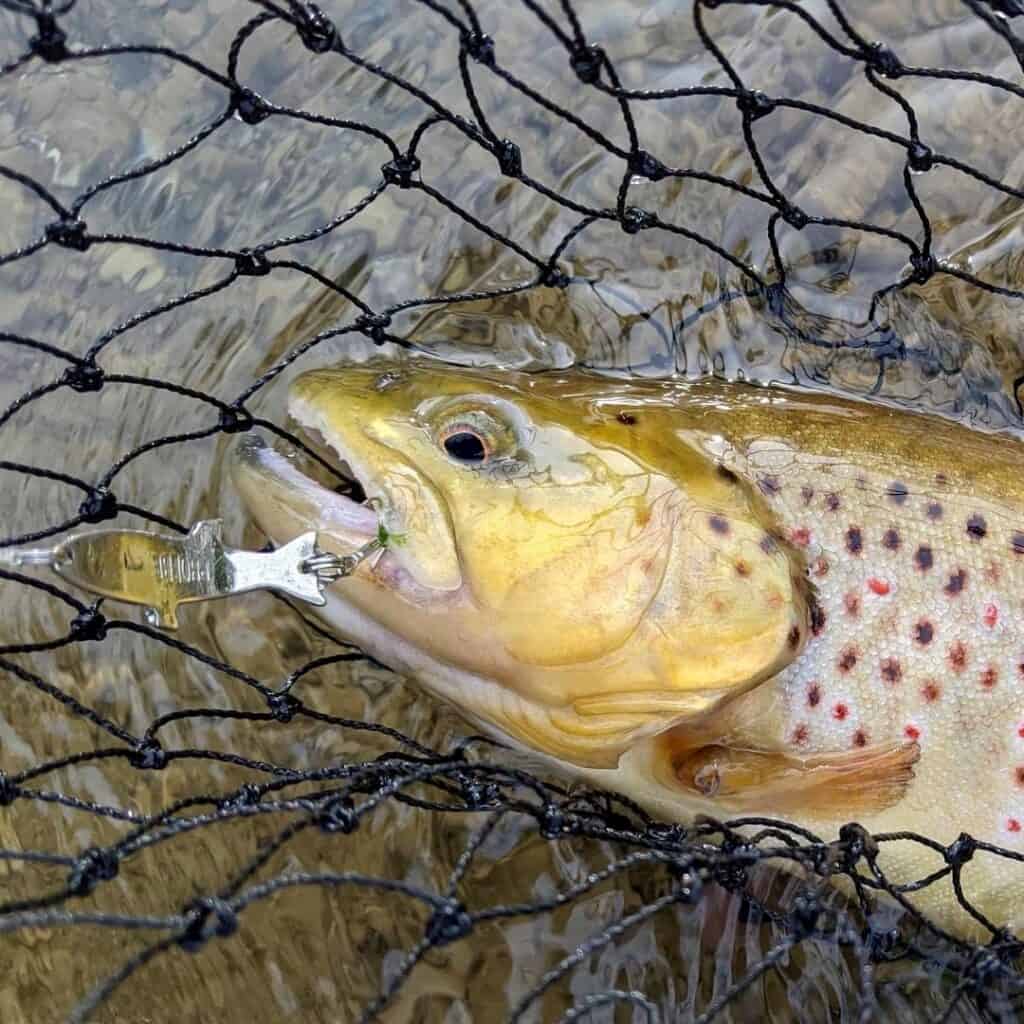Brown trout may not be from around here, but they have become a favorite for American trout anglers.
Brown trout, whether they’re the first fish I catch in the spring or the last before ice locks the water, has been a favorite species of mine for years.
This complete angler’s guide will break down the basics of how to find and catch brown trout just about everywhere they live in the United States.
First, a little bit about why I (and many others) love fishing for brown trout so much:
- They are versatile enough to be at home on the smallest creeks and to be the apex predator on some of the largest lakes.
- They’re colorful, hard-fighting and increasingly savvy as they age.
- They can be caught with flies so small you’ll need a magnifier to see them or with lures as big as a rat.
- They’re often one of the first fish we target as new anglers, but they also can demand the best from the most experienced anglers.
Additionally, among trout found in the U.S., browns are second only to lake trout in potential to grow to mammoth proportions given perfect conditions. Arkansas, Michigan, and Missouri have all produced brown trout over the 40-pound mark, and the first two of those are past world records.
Where to Catch Brown Trout
Brown trout can inhabit some of the most diverse regions on the planet. From rivers in South America where anadromous browns can push 20 pounds to the Barents Sea north of Finland, they’re a global fish.
In North America, brown trout date back to when the first specimens arrived from Europe in the 1880s.
That means no brown trout are native to the United States, unlike species such as brook and rainbow trout.
However, in many colder waters across America, brown trout have made themselves right at home with self-sustaining populations of fully wild fish. Browns may also be part of your state’s regular stocking routine.
Typically, wild brown trout will have greater color variation because their diet is more varied, and many anglers will tell you they fight differently than stocked fish.
There are four main sub-categories of brown trout in the United States:
- Moving-water fish live in a stream or river year-round
- Lake-run brown trout spend most of their lives in a lake and swim into rivers to spawn
- Lake brown trout spend the entirety of their lives in ponds, lakes and reservoirs
- Sea-run brown trout, the least common form in the U.S., spend part of their life cycle in the Atlantic Ocean but swim up freshwater streams to spawn
We’ll address the major freshwater habitats that most brown trout inhabit in the Continental U.S. to help you have the greatest success.
When to Catch Brown Trout
Let’s take a look at brown trout fishing through the seasons.
Spring Brown Trout Fishing
The spring is historically the most popular, and arguably the most productive, time to target brown trout in many states.
The reasons are numerous but in some states, it comes down to state agencies tend to stock the most hatchery-reared browns in the early season.
Many anglers can look on their state’s website to see which streams, lakes and rivers are stocked and when. If a lake or stream is heavily stocked, it likely has been for years, and you might have improved odds of catching larger holdover browns.
After some sustained warmer weather, water temperatures will shift dramatically in the spring. This is when you’ll notice increased activity among the fish.
With a species like brown trout that is present and feeding year-round, there is no magic number for temperature when targeting these fish. Still, I consider 50 degrees a good number to keep in mind if you are carrying a stream thermometer.
When water temperatures reach 50 Fahrenheit, you will see more insects hatching. That’s when trout will shift into a spring feeding pattern, when they’ll be most active at first and last light.
This seasonal shift is not an overnight change. While in the cold months of winter you were likely having your best luck at midday, you’ll now want to focus your fishing on the cooler, lower-light hours as water temperatures rise.
When that shift occurs will vary by region and water temperature.
Late March, April and May are typically great trout months in the Northeast, upper Midwest, and Northwest. States farther south may see brown trout activity pick up in late February and early March.
Fly anglers will see trout rising to insect hatches as the water warms. April, May and June are popular months to target brown trout with dry flies.
In lakes and streams, springtime trout will orient themselves to structure such as fallen trees, submerged bars or rockpiles, underneath undercut banks, or in deeper pools with a slower current.
Find abnormalities in the body of water you’re fishing, whether it’s structure or a sudden depth change, fish around the beginning and end of daylight, and mimic the predominant forage, and you’ll increase your chances of success.
Once water temperatures begin climbing through the 60s, brown trout shift into summer mode.
Summer Brown Trout Fishing
Targeting brown trout successfully in the summer can be challenging.
Warmer water and the lower oxygen levels that accompany it will make brown trout far less active, especially as temperatures rise into the 68-degree range or warmer.
There will be two prime summertime feeding times for bigger browns: First light and night.
On bodies of water in the southern part of the brown trout range, and especially for the largest specimens, targeting them at night becomes almost necessary where it’s allowed. We have a section later in this article with more specifics on night fishing for browns.
Often in stocked streams or ponds, water temperatures will reach a point in July or August where many of the stocked fish do not survive, and these months can be some of the most challenging for brown trout anglers everywhere.
In ponds and lakes that stay cooler, you can still catch brown trout in the summer months, but they will often be in the deepest water.
Fall Brown Trout Fishing
The fall can be one of the most incredible times to target browns, and it’s when you have the best chance at landing your biggest brown.
Browns are a fall-spawning species that prefer to lay eggs in shallow, sheltered areas where their young will have the best chance of early survival.
What this means for anglers is that fish that typically spend most of their lives roaming through large lakes or ponds are, for a short time, in a shallow stream that is definitely more accessible.
Brown trout are not a species that gets lockjaw while on their spawning run, but they are apt to behave differently. They will strike larger flies or lures out of aggression or to protect a spawning redd.
Fishing at this time of year depends more on water temperatures and precipitation. Rainfall and declining temperatures will spark spawning behavior, so when those conditions arrive in the fall, look for browns to move from lakes into tributary streams.
Each autumn, brown trout will often return to specific sections of the same stream, or even the same holes. Learning a body of water and having a good idea for timing can all be crucial.
For example, on one of my favorite streams, there is a specific brown trout that I know will return to a particular hole between the third week of September and the first week of October.
Spawning fish typically look for areas with deeper water, gravel substrate, cover such as an undercut bank, overhanging trees or around large rocks, and where there is current nearby.
Another valuable tip: The lowest stretch of a stream before it empties into the lake can be an incredible place to target big browns in the early fall.
Winter Brown Trout Fishing
Of all the seasons in which you can target brown trout, winter is the most predictable and the most difficult, simultaneously.
Winter fishing in open water is the most predictable because it is almost guaranteed that if these fish feed, it will be in the middle of the day, usually about 11 a.m. and 2 p.m., when the water temperature is warmest.
Yet winter is the most difficult because as water temperatures fall, brown trout become less and less active and subsequently less inclined to feed.
So, even if you know exactly when to be on the stream, the first trick is finding them when they’re feeding.
The second wintertime trick is presenting a lethargic brown trout with the slowest offering that you can. A spoon or stick bait that is barely moving or a streamer that is lazily moving through the water column can mimic a meal that a relatively inactive brown will want to eat without a big chase.
While it can be one of the most challenging times of year to get fish to cooperate, there’s something to be said about catching brown trout with snow falling; it’s a surreal experience.
The challenge is that you have to get your lure as close to these fish as possible, but you have to do it without spooking them.
In a lake or pond, however, wintertime browns may move into shallower areas, between 5 and 15 feet, where they’ll have the best chance at corralling bait. If those waters will be frozen, see our ice fishing section below.
How to Catch Brown Trout
Stream Fishing for Brown Trout
Streams can be one of the most predictable places to consistently find and catch brown trout.
There are three keys to finding feeding trout in moving water. They are: Finding forage, ideal temperature and the presence of oxygenated water.
In the spring and fall, water temperatures in most northern states will be in the 40- to 65-degree range, which is ideal. However, as water temperatures rise in the summer, two places will be more likely to hold fish: Fast-moving, oxygenated water and deeper pools with cooler water.
In the fast-moving water, look for a fallen tree, large rock, undercut bank or a similar structure that will give trout some respite from the consistent flows while keeping them in the more oxygenated water.
Small spoons and stickbaits, streamers and dry flies will be your most effective means to target moving-water browns.
In the winter, stream trout will try to conserve energy near a part of the stream where they can easily feed, so the deepest pools will hold most browns once water temperatures get below 40 degrees.
Lake Fishing for Brown Trout
Browns often hunt in shallower water at first ice-out. Shore anglers can catch them by casting spoons and stickbaits.
However, brown trout will quickly seek out deeper water as spring and summer warm the lake.
Once the surface water becomes too warm to hold sufficient oxygen for these fish, they will move to the deepest, coldest parts of the lake.
After a thermocline has set up, finding this line with a fishfinder and trolling right at or underneath it with baits that mimic the predominant forage will be your best bet.
One popular method for anglers who have become adept at reading their fishfinders is to locate schools of bait and vertically jig through the school. You can drop either spoons or heavier jigs straight down and reel the lures up through the school of bait to mimic a baitfish fleeing toward the surface.
Brown Trout Fly Fishing
Books have been written about targeting brown trout with flies, and truth be told, you can keep learning about this niche in the sport for as long as you live without ever fully mastering it.
Still, some basic strategies will get you started targeting brown trout on the fly.
There are four main ways of fly fishing for brown trout.
The first is dry fly fishing, where you are mimicking an insect hatching or landing on the surface.
Presenting a dry fly with what fly anglers call a “drag-free drift” is the goal. Simply put, you want your fly to float naturally with the current speed.
To find out which dry fly to mimic, Google “water temperature and hatches” to find a guide pertinent to your geographic location.
When you find out, for example, that blue-winged olives hatch when water temperatures are between 45 and 55 degrees, you can start by checking your local stream’s water temperature. Next, “match the hatch” by mimicking the insect that will likely be “coming off” and fishing it in areas where trout will likely be holding.
As mentioned earlier, trout will typically be near an abrupt depth change or around a larger structure in a stream if they are waiting to rise to a hatch.
The second fly-fishing tactic you’ll want to deploy at times is nymphing. Here you are mimicking an insect in the larval stage of its life cycle and drifting it through the middle or at the bottom of the water column.
The third approach is streamer fishing, which means using a fly to mimic a crayfish or baitfish and stripping it through the water column, retrieving it as you might a lure.
Learning the main baitfish in a stream or lake and choosing a streamer that looks like it is a great place to start. Examples of common baitfish that browns may gobble are shiners, dace, and various minnows, and there are fly patterns to fit the bill.
The last fly-fishing method I’ll mention is euro-nymphing, which is growing in popularity.
Euro-nymphing is similar to traditional nymphing except that anglers use a specialized leader to indicate the depth of their nymph rather than an indicator. The leader in a euro nymphing set-up has alternating bands of color so you can tell how deep your nymph is at any given time and more easily see a strike.
Night Fishing for Brown Trout
For those seeking to target trophy browns, night fishing can give you shots at fish you’d not catch otherwise. The biggest brown trout will often be strictly nocturnal feeders, especially in warmer conditions.
Large profile baits, such as stickbaits or large streamers or mouse pattern flies, will be your most effective choice. Hefty browns will look for a big meal or sense the movement of your larger lure along their lateral lines.
Although deeper holes and pockets can still be good areas to target in streams, browns will be more apt to move into open water once night falls, so work the entire breadth of a stream or lake.
Violent jerks followed by pauses (strip, strip, pause for streamer anglers), can be effective because fish will detect sudden movement more readily.
At night especially, topwater tactics can prove successful because they will stand out on the surface. Fish half the speed that you typically might and cover more water.
Brown Trout Ice Fishing
Ice fishing for brown trout can be an incredible way to keep targeting these fish between the fall and spring seasons.
Once a lake freezes over, browns likely will be in the shallower bays and coves near structure like boulders, drop-offs, or sunken trees.
Try this: Google ‘ice fishing brown trout,’ and look at the photos that come up. You will notice in almost all of them that the shoreline is visible in the immediate background. That’s not an accident: These fish are in shallow water in the winter.
Your best bet for big browns through the ice will be locating shallow structures and setting up tip-ups with shiners or other live minnows as local regulations allow.
At the same time, use a jigging rod to work a Rapala Jigging Rap in various holes. Keep moving as the day goes on while keeping an eye on your tip-ups.
Best Brown Trout Lures and Bait
Artificial Lures
The variety of lures anglers use to catch brown trout could boggle anyone’s imagination, but there are some reliable patterns that succeed year in and year out. We’ll divide them into categories and suggest specific lures in each.
Stickbaits
Not every brown trout will be tempted to hit a stickbait, or a jerkbait, because it typically presents a larger meal. But the lunkers you really want to catch certainly will.
The biggest brown trout in a river, smaller stream or lake will feed primarily on smaller baitfish, other stocked trout, or even rodents.
An excellent first step in choosing a stickbait size and pattern will be investigating a lake or stream to learn about its predominant forage. For example, if browns feed on alewives there, a stickbait that mimics this baitfish’s profile and color can be deadly.
The classic black and silver Rapala can be an effective bait for larger brown trout, as can the ‘trout’ pattern Rapala.
Whichever lure you choose, an erratic retrieve that best mimics the behavior of a wounded baitfish will often be the most productive. Long pauses with sharp jerks can work well for bigger browns, and a twitch-twitch-pause retrieve can elicit strikes, too.
Diving or sinking hard baits, including long-billed crankbaits, can also be excellent options for trolling for brown trout in larger lakes.
Again, mimic the browns’ favorite food source and work your lures around the structure and at depths that suit the conditions. Trolling will allow you to cover plenty of water and experiment with lure patterns, water depths, and cover types.
Spoons
Spoons are among the oldest and most effective bait trout anglers can employ. The sizes, colors, and variations are almost innumerable, but some proven winners are Phoebe Wobblers, Little Cleos, Daredevles, and Acme Kastmasters.
Specific colors will come down to angler preference, but a solid place to start is using silver spoons in clear water and gold spoons in murky conditions.
I use a lot of spoons, and it has been my experience that smaller lures will typically catch a greater variety in the size of browns you’ll hook but won’t necessarily inhibit larger fish from striking. Larger spoons may prevent you from catching lots of smaller fish.
You can cast spoons into moving water or cast or troll with them in lakes. For open water, try working them around the thermocline, structures or drop-offs.
Trolling spoons between 2 and 4 miles per hour has proven effective for brown trout in many bodies of water.
Spinners
Spinners like Panther Martins and Vibraxes have been staples of the brown trout tackle box for decades.
As with spoons, the variety is almost endless, but the silver/gold suggestion still applies to color selection.
Heavier spinners are excellent for targeting fish holding in deeper water.
The Blue Fox Trout Vibrax Minnow Spin is a unique combination of stickbait and spinner that offers a dual appeal of a stickbait and a spinner simultaneously.
Soft Plastics
Though typically thought of as a bass bait, soft-plastic baits either rigged weightlessly or on a jighead can definitely be successful trout tools.
Curly-tail grubs or twitch-baits like a Slug-Go can both be great at enticing trout to eat, especially larger fish that have graduated to baitfish as the predominant forage in their diet.
Best Brown Trout Baits
Nightcrawlers and Trout Worms
If you can remember your first caught trout, odds are it was taken on a worm.
In most places in the U.S., you’ll have two varieties of live bait worms: nightcrawlers and trout worms.
The trout worms, which you might call red wigglers or redworms, are smaller and work better on the smaller hooks typically employed for browns.
For best results, use a worm or piece of nightcrawler no longer than 3 inches, and hook it multiple times, wrapping it around the hook shank to give the fish a concise target that’s hard to pull off without getting hooked.
Worms can be fished off the bottom, perhaps using small split-shot weights to get into the best holding water. Fishing worms under a float also can be a great tactic.
Mealworms
One of the most effective baits I’ve ever seen employed for big browns is mealworms.
These beetle larvae, rarely larger than an inch long, are yellow or white and can be fished best on a fly hook.
You can fish mealworms with the help of a tiny split shot or unweighted under an indicator. Fly tackle is often the best approach with such light baits.
You may be able to buy mealworms at your local bait shop, but another place to find them is in pet stores, which sell them as live food for everything from reptiles to rodents.
Eggs
Brown trout eggs or salmon eggs, sold at bait and tackle stores, can be especially effective during the fall spawning run.
Fish these baits weightlessly, underneath a float or indicator, and target slower pools or pockets where spawning trout will hold.
The key with fishing eggs will be to present them in the current with a natural drift. Avoid any weight or float that makes the egg go faster or slower than the surrounding current.
Grasshoppers (or Crickets)
For a short time at the end of the summer and the beginning of the fall, trout key on hoppers hitting the water. Big brown trout won’t hesitate to attack a grasshopper that hits the water’s surface before the big bug can lift off.
Not many bait stores I’ve seen sell grasshoppers, but some tackle and pet stores sell live crickets, which can be close enough for hopper-crazed trout.
Or task your children with having fun catching grasshoppers while you’re digging worms for a pre-fishing family activity.
Here again, it will be easiest to use fly tackle for the sizes of the hooks that you’ll need to fish this tiny bait.
Minnows/Shiners
Fishing with live minnows, where it’s legal, isn’t as popular for trout as they are for bass and crappie.
You’re probably out of luck carrying live minnows if you’re walking far or wading, but some boats are equipped with livewells to more easily keep active baits.
And live minnows can be deadly for larger browns.
Fish a minnow beneath a slip bobber, drifting it through pools or pockets on a stream, or try near drop-offs or structures on a lake.
Crayfish
Crawfish are typically more associated with smallmouth, but big brown trout will eat these mudbugs.
Hook live crayfish through the tail and cast them toward rocks. Try ripping off one claw if your crawfish is not getting attention.
Leeches/Helgrammites
Leeches and helgrammites round out the list of the best natural baits for brown trout.
Leeches are more popular with the walleye set, but browns will attack them, too.
Helgramites, a larval bait, can be a good choice in an area where trout see a lot of bait thrown their way.
While big browns might have become worm-wary, a smaller and less common bait like a hellgrammite presented on a natural drift could prove effective for larger fish.
PowerBait
Often, one of the first baits used by young anglers, perhaps instead of a worm, is Berkley PowerBait or a similar prepared dough bait.
This scented, flavored creation is an opening-day favorite because it can be enormously effective at getting strikes, especially with those less sophisticated stocked trout accustomed to eating in a fish hatchery.

